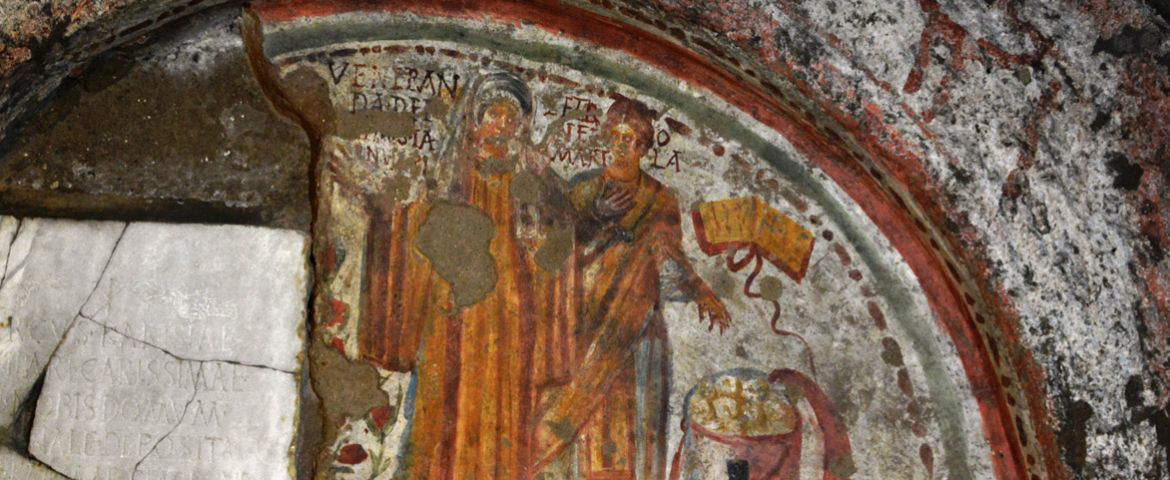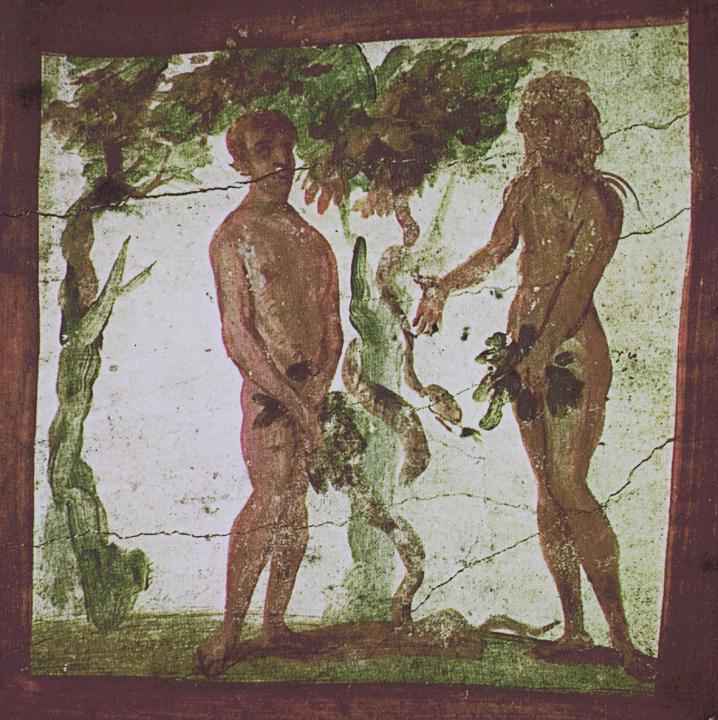The catacombs of Rome constitute a vast system of underground cemeteries located along tunnels that extend beneath the city. These catacombs were primarily used as burial sites during the first centuries of Christianity. The Roman catacombs originated during the period of the Roman Empire, beginning in the second century. Many of the earliest Christians were buried in these catacombs because of their religious beliefs (in fact, Christianity believed that the doctrine of the resurrection of the flesh was incompatible with cremation, which was practiced by pagans instead), consequently long cemeteries were carved out underground to give Christians a proper burial. Catacombs consist of a network of corridors, chambers and loculi (burial niches) carved into the rock. These tunnels can extend for miles underground, and some catacombs also contain rooms used for worship meetings and religious celebrations. The catacombs are an important historical landmark for the study of early Christianity, as they contain frescoes, graffiti and inscriptions that testify to the faith and practices of those times. Today, many of Rome’s catacombs are open to visitors interested in discovering their history and importance, while others are accessible only to experts. Indeed, scholars and archaeologists continue to study the catacombs to better understand the lives and beliefs of early Christians, as well as to explore the history of ancient Rome. Preserving the catacombs, however, is a challenging task because of the challenges related to moisture, rock degradation, and the influx of visitors. However, efforts have been made to preserve these important historical records for future generations. Many catacombs can be visited: here is a guide to Rome’s catacombs for those who would like to discover this peculiar aspect of the city’s history.
It is the catacomb par excellence, since it was the official cemetery of the Church of Rome in the 3rd century, and given its extent one can also speak of it in the plural (“the catacombs” of St. Callistus). The Catacomb of St. Callistus is in fact one of the most important and largest catacombs in Rome. It is named after Pope Callistus I, who ruled the Church in the third century and was one of the first to recognize the importance of the catacombs as burial places for Christians. This catacomb is located along the Via Appia Antica, one of the main access roads to the city of Rome. The Catacomb of St. Callistus is spread over several underground levels reaching a total length of about twenty kilometers, and it is estimated that about half a million Christians were buried here. This catacomb is divided into several areas, each of which contains several tunnels and burial niches. It is also notable for the presence of numerous tombs of martyrs, popes and saints (in fact, the burials of as many as sixteen popes are counted). These catacombs were an important burial site for early Christians, especially during periods when the practice of Christianity was subject to persecution. The frescoes, graffiti and inscriptions inside provide valuable information about the life and faith of the early Christians. Within the Catacomb of St. Callistus are a number of crypts that have traditionally been associated with popes and bishops. For example, the Crypt of the Popes is an area of this catacomb where nine popes are buried. The Catacomb of St. Callistus is open to the public and can be visited to discover its history and importance.

The Catacomb of Domitilla is another of the important catacombs in Rome. It is named after a Domitilla who belonged to the family of the Flavians, who may have owned the land on which the catacombs were built. This catacomb is one of the largest and best preserved in Rome, and is located along the Via Ardeatina. Excavated in the tufa, it extends over several underground levels and covers a large area that in several parts bears interesting wall paintings, one of the main attractions of the catacomb: scenes from the life of Jesus, biblical episodes but also pagan figures (e.g. depictions of Orpheus). Especially famous is the wall painting depicting the Good Shepherd, one of the earliest known works of Christianity. A curiosity: in 1965 the “Covenant of the Catacombs” was signed here, an agreement between a number of cardinals, mainly Brazilians and Latin Americans, a few days before the end of the Second Vatican Council: with the covenant they pledged to live in poverty according to the Gospel, renouncing the privileges arising from their office.

Named after St. Pancratius, a young Christian martyr who lived between the 3rd and 4th centuries. Located along the Via Vitellia, a short distance from the Aurelia Antica (where St. Pancratius was martyred), the Catacomb of St. Pancratius has an interesting and significant history especially as it is linked to the cult of the saint, for whom, between the 4th and 5th centuries, Pope Symmachus also had a basilica erected right above the catacomb: as a result, there are two entrances inside the basilica that lead to the underground burials. The catacomb consists of a series of corridors, chambers and loculi carved into the rock: however, it is one of the worst preserved.

Among the best-known and most visited catacombs in Rome, the Catacomb of St. Sebastian, along the Via Appia Antica, was used as a burial site within an abandoned pozzolan quarry in the late 2nd century, on which the imposing basilica of St. Sebastian Outside the Walls (known as ad catacumbas precisely because of the presence of the vast underground cemetery) was later built by Emperor Constantine in the 4th century. Tradition states that St. Sebastian, a Roman soldier who converted to Christianity and was later martyred, was buried in this catacomb in the 3rd century. His devotion and martyrdom made the catacomb an important place of veneration for the faithful (the remains were later moved to St. Peter’s in the 9th century). Ancient sources also attest that two other martyrs, Quirinus and Eutychius, were buried here. Here, too, parts of the catacomb are decorated with frescoes, graffiti and inscriptions depicting biblical scenes, Christian symbols and images of faith. The crypt of St. Sebastian, on the other hand, preserves a 17th-century bust of the saint.

The Catacomb of Priscilla is one of the most famous catacombs in Rome and in ancient times was also known as the “Queen of the Catacombs” because of the importance of the personalities who were buried here. It is named after the Christian matron Priscilla, who is traditionally believed to have donated the land in which the cemetery was excavated. This catacomb is located along the Via Salaria, one of the ancient routes into the city of Rome. A distinguishing feature of the Catacomb of Priscilla is the presence of “cubicles,” larger burial chambers decorated with frescoes and drawings: for example, the cubicle of the Veiled, so called because of the presence of a fresco depicting a veiled woman shown praying. Next we visit the Greek Chapel, with several scenes depicting episodes from the Old and New Testaments. The Catacomb of Priscilla is also the burial place of as many as seven popes: Marcellinus, Marcellinus I, Sylvester I, Liberius, Siricius, Celestine I, and Vigilius.

Dedicated to St. Agnes, a young Christian martyr from the 3rd-4th centuries, the only martyr reported by ancient documents to be buried in this catacomb. The Catacomb of St. Ag nes is one of the oldest burial sites and consists of a network of corridors, chambers and burial niches dug into the tuffaceous rock and arranged on three levels, in turn divided into four areas, which were developed at different times. The peculiarity of the Catacomb of St. Agnes is that it is very poor in paintings, but is instead rich in epigraphs and inscriptions. Also on the site of St. Agnes’ burial, a church dedicated to her was built in the 5th century, then rebuilt in the 7th century, when it took its present form as a partially buried basilica. This site thus represents an important place of veneration and history of early Christianity in Rome: its association with St. Agnes and its epigraphic evidence offer a unique opportunity to learn more about the life and faith of early Christians and to explore the city’s ancient heritage.

Located along the Via Casilina, the Catacomb of Saints Marcellinus and Peter is one of the oldest in Rome, since it was a burial site from the early second century. Access is from the Church of Saints Marcellinus and Peter ad Duas Lauros and is dedicated to Saints Marcellinus and Peter, two fourth-century Christian martyrs who were killed during Diocletian’s persecutions. The catacomb continued to be used for centuries. It consists of a series of underground tunnels covering an area of about 18 thousand square meters (it is estimated that more than 15 thousand burials were housed there). Many rooms are decorated with frescoes: it was in fact the burial place of particularly wealthy Christians.

The Catacomb of Pretestato is located in the Appio-Latino district and is situated on the route of the Appia Antica. Used as a cemetery since the 3rd century, it is known because it is rich in works of art, including pagan ones, since Christian burials were made in a catacomb where prominent personalities were already buried earlier (the well-known 3rd-century Sarcophagus of Emperor Balbinus was discovered here). Little-known as it is, in fact, the catacomb of Pretestato is one of the most artistically valuable (see the scene with the Coronation of Christ, from the 3rd century, that decorates one of the cubicles: it is believed to be one of the oldest examples of Passion episodes). It also has a special feature: it is the only Roman catacomb where there was a keeper’s house. It can be visited upon request.

Along the Via Ostiense stands the catacomb of St. Thecla, dedicated to the saint of the same name about whom, however, we have no reliable information. It dates from the 3rd century and features a series of corridors and chambers (twenty-two in all, arranged along three ambulatories) that are arranged around the small 4th-century underground basilica where, according to tradition, St. Thecla was buried. It stands out because the walls of the cubicles are almost entirely covered with frescoes, although they are in a poor state of preservation. In 2009 an image of St. Paul was discovered here that is believed to be the oldest known depiction of the saint (it dates back to the fourth century), included in a cycle of roundels with the faces of the apostles (Peter, Andrew and John also appear, and the image of St. Thecla is believed to be the oldest known to us for them as well). This catacomb is also open for visits by request only.

Another catacomb that can be visited only by request, the Catacomb of Generosa is named after the woman who, according to tradition, donated the land under which the underground cemetery was dug. It is located in the Portuense district, not far from the Tiber. It was carved out of the tunnels of an abandoned pozzolan quarry, so between the 3rd and 4th centuries the quarry was reused as a burial place (the martyred saints Simplicio, Faustino and Beatrice, among others, were buried there). Next to the catacomb stood a basilica, built by Pope Damasus, the remains of which were discovered in the 1980s.

 |
| Catacombs of Rome, which ones to see: guide to the 10 most interesting ones |
Warning: the translation into English of the original Italian article was created using automatic tools. We undertake to review all articles, but we do not guarantee the total absence of inaccuracies in the translation due to the program. You can find the original by clicking on the ITA button. If you find any mistake,please contact us.